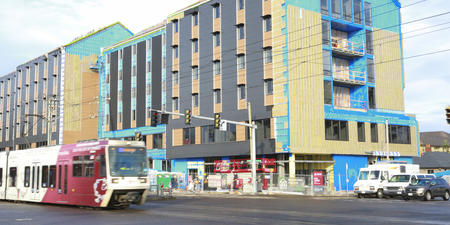Workforce & Investment Climate
Report Home // Portland’s Story // East Multnomah County // Prosperity & Productivity // Opportunity & Affordability // Workforce & Investment Climate // Why This MattersThis category measures labor force characteristics, startup firms, and employment and population statistics for each region. Both Portland and its peer regions are becoming more educated. In fact, Portland now boasts nearly 50 percent of residents with an associate’s degree or higher, an increase of more than 9 percent since 2010. Occupations in science, technology, engineering and mathematics (STEM) have declined slightly since last year. Despite this trend, Portland still leads Nashville, Indianapolis and Salt Lake City in this measure.
Portland and Nashville alone saw increases in the share of workforce employed at a young business, reinforcing our region’s global entrepreneurial reputation.
Employment & Population
Population growth is slowing in the Portland region after many years of steady increase. This is the case for all age groups, and more troubling, for those between the ages of 25-34. This demographic has experienced strong growth of in-migration in recent years, contributing to the vitality of the region. See Figures 19 and 20. Portland has experienced strong employment growth since 2010, growing by almost 19 percent, placing it in the middle of its peer regions and slightly outpacing Seattle at 18 percent. See Figure 21. While Portland remains at the bottom of the pack for employment rate compared to its peer regions, in 2018, the region hit 96.24 percent, indicating that nearly all residents of working age are employed. See Figure 22. However, when compared to Portland’s employment to population ratio, nearly half of the region’s residents (47.7 percent) were not employed in 2017. See Figure 23.
LABOR FORCE CHARACTERISTICS
Both Austin and Portland have a slightly smaller share of jobs in STEM occupations compared to findings in 2016. However, Portland still sits just behind Seattle and Austin at an estimated 14 percent of the workforce. See Figure 24.
Portland and its comparison regions saw increases in the estimated foreign-born population with a bachelor’s degree. See Figure 25. This indicates newcomers to the region are highly educated, and indeed, residents are also achieving higher levels of education compared to years past.
Nearly 50 percent of the Portland region’s population over the age of 25 have an associate’s degree or higher (AA+), just behind Austin and Seattle. See Figure 26. Portland has seen the largest increase of population with an AA+ of all peer regions since 2010. See Figure 27.
STARTUPS
Venture capital funding is volatile from year to year, but comparing the relative differences in funding normalized by the population can provide insights into an area’s ability to draw in venture funds. Portland’s per capita venture capital investments in 2017 were most similar to Salt Lake City, but were about half of the rate of investment in Austin and one-third of Seattle. See Figure 28.
Only Nashville and Portland experienced an increase in the share of jobs at young businesses in 2017, supporting the reputation of small business entrepreneurship in both regions. The share of jobs in young business at 12 percent in Portland trails, Nashville at 14 percent and Austin at 15 percent. See Figure 29.

Prosperity & Productivity

Opportunity & Affordability

Workforce & Investment Climate
